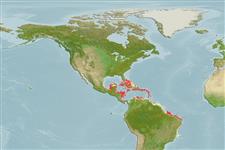>
Gobiiformes (Gobies) >
Gobiidae (Gobies) > Gobiinae
Eponymy: Isaac Ginsburg (1886–1975) was a Lithuanian-born goby taxonomist at the US National Museum and for the US Fish & Wildlife Service. [...] (Ref. 128868), visit book page.
More on author: Fowler.
Environment: milieu / climate zone / depth range / distribution range
Écologie
marin récifal. Tropical; 27°N -
Western Central Atlantic: The Bahamas, Cayman Islands, and Antilles south to Venezuela and Colombia (Ref. 092840).
Taille / Poids / Âge
Maturity: Lm ? range ? - ? cm
Max length : 2.5 cm TL mâle / non sexé; (Ref. 7251)
Épines dorsales (Total) : 7; Rayons mous dorsaux (Total) : 12; Épines anales: 0; Rayons mous anaux: 10. Distinguished by having the following characteristics: dark brown body with nine, bright blue, thin, vertical lines; presence of rostral frenum (Ref. 92840).
Inhabits shallow areas with clear water and coral formations (Ref. 13628), often in close association with the sea urchin Echinometra lucunter. Possesses a ventral sucking disk which allows it to adhere to the rock beneath the test of an urchin with only the head showing among the spines of urchins. When disturbed they retreat farther beneath the urchin, and if the urchin is removed it rapidly darts beneath the test of a neighboring one. Feeds mainly on the tube feet of sea urchins (Ref. 33548)..
Life cycle and mating behavior
Maturité | Reproduction | Frai | Œufs | Fécondité | Larves
Robins, C.R. and G.C. Ray, 1986. A field guide to Atlantic coast fishes of North America. Houghton Mifflin Company, Boston, U.S.A. 354 p. (Ref. 7251)
Statut dans la liste rouge de l'IUCN (Ref. 130435: Version 2024-1)
Menace pour l'homme
Harmless
Utilisations par l'homme
Pêcheries: commercial; Aquarium: Commercial
Outils
Articles particuliers
Télécharger en XML
Sources Internet
Estimates based on models
Preferred temperature (Ref.
123201): 26.7 - 28.2, mean 27.5 °C (based on 600 cells).
Phylogenetic diversity index (Ref.
82804): PD
50 = 1.0000 [Uniqueness, from 0.5 = low to 2.0 = high].
Bayesian length-weight: a=0.01023 (0.00477 - 0.02194), b=3.01 (2.83 - 3.19), in cm total length, based on LWR estimates for this (Sub)family-body shape (Ref.
93245).
Niveau trophique (Ref.
69278): 3.0 ±0.00 se; based on food items.
Résilience (Ref.
120179): Haut, temps minimum de doublement de population inférieur à 15 mois (Preliminary K or Fecundity.).
Fishing Vulnerability (Ref.
59153): Low vulnerability (10 of 100).
Nutrients (Ref.
124155): Calcium = 383 [168, 1,323] mg/100g; Iron = 1.93 [0.82, 4.27] mg/100g; Protein = 18 [16, 20] %; Omega3 = 0.17 [0.05, 0.54] g/100g; Selenium = 40.1 [11.9, 113.9] μg/100g; VitaminA = 90.2 [17.0, 456.9] μg/100g; Zinc = 4.8 [2.6, 8.0] mg/100g (wet weight);
